Business and the Business Environment: Analysis and Evaluation Report
VerifiedAdded on 2023/01/11
|23
|5519
|63
Report
AI Summary
This report provides a comprehensive analysis of the business environment, examining various organizational types, including public, private, and voluntary sectors, along with their legal structures and purposes. It explores the size and scope of different organizations, differentiating between micro, small, medium, and large entities, and explains the relationship between organizational functions and objectives. The report delves into the macro environment, identifying its positive and negative impacts on business operations, supported by specific examples. Furthermore, it conducts internal and external analysis of organizations, utilizing frameworks such as SWOT analysis to identify strengths, weaknesses, opportunities, and threats. The analysis extends to explaining how internal strengths and weaknesses interrelate with external macro factors, providing a holistic understanding of the business environment. The report concludes with a detailed discussion of the findings and implications for business strategy and performance.
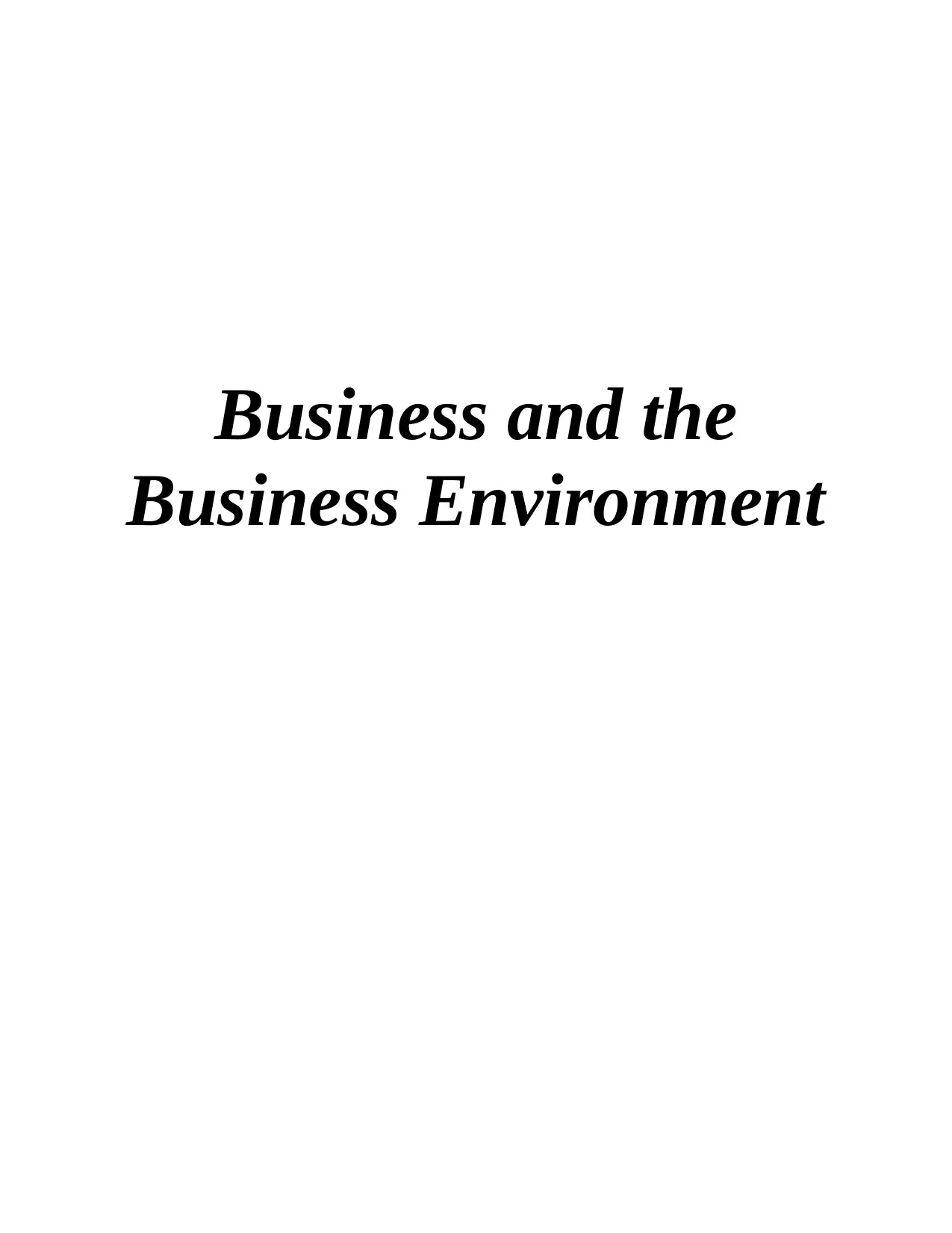
Business and the
Business Environment
Business Environment
Paraphrase This Document
Need a fresh take? Get an instant paraphrase of this document with our AI Paraphraser
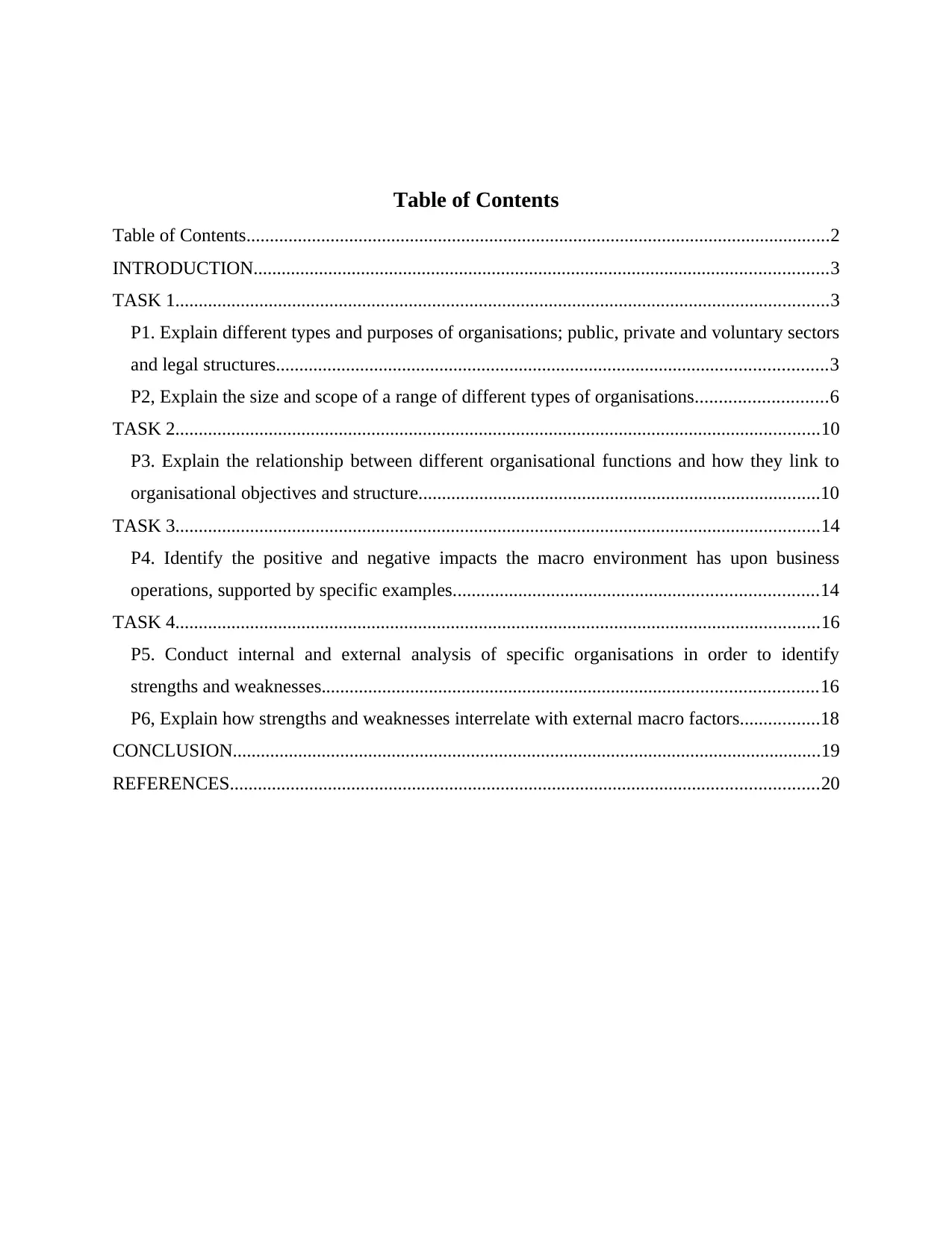
Table of Contents
Table of Contents.............................................................................................................................2
INTRODUCTION...........................................................................................................................3
TASK 1............................................................................................................................................3
P1. Explain different types and purposes of organisations; public, private and voluntary sectors
and legal structures......................................................................................................................3
P2, Explain the size and scope of a range of different types of organisations............................6
TASK 2..........................................................................................................................................10
P3. Explain the relationship between different organisational functions and how they link to
organisational objectives and structure......................................................................................10
TASK 3..........................................................................................................................................14
P4. Identify the positive and negative impacts the macro environment has upon business
operations, supported by specific examples..............................................................................14
TASK 4..........................................................................................................................................16
P5. Conduct internal and external analysis of specific organisations in order to identify
strengths and weaknesses..........................................................................................................16
P6, Explain how strengths and weaknesses interrelate with external macro factors.................18
CONCLUSION..............................................................................................................................19
REFERENCES..............................................................................................................................20
Table of Contents.............................................................................................................................2
INTRODUCTION...........................................................................................................................3
TASK 1............................................................................................................................................3
P1. Explain different types and purposes of organisations; public, private and voluntary sectors
and legal structures......................................................................................................................3
P2, Explain the size and scope of a range of different types of organisations............................6
TASK 2..........................................................................................................................................10
P3. Explain the relationship between different organisational functions and how they link to
organisational objectives and structure......................................................................................10
TASK 3..........................................................................................................................................14
P4. Identify the positive and negative impacts the macro environment has upon business
operations, supported by specific examples..............................................................................14
TASK 4..........................................................................................................................................16
P5. Conduct internal and external analysis of specific organisations in order to identify
strengths and weaknesses..........................................................................................................16
P6, Explain how strengths and weaknesses interrelate with external macro factors.................18
CONCLUSION..............................................................................................................................19
REFERENCES..............................................................................................................................20
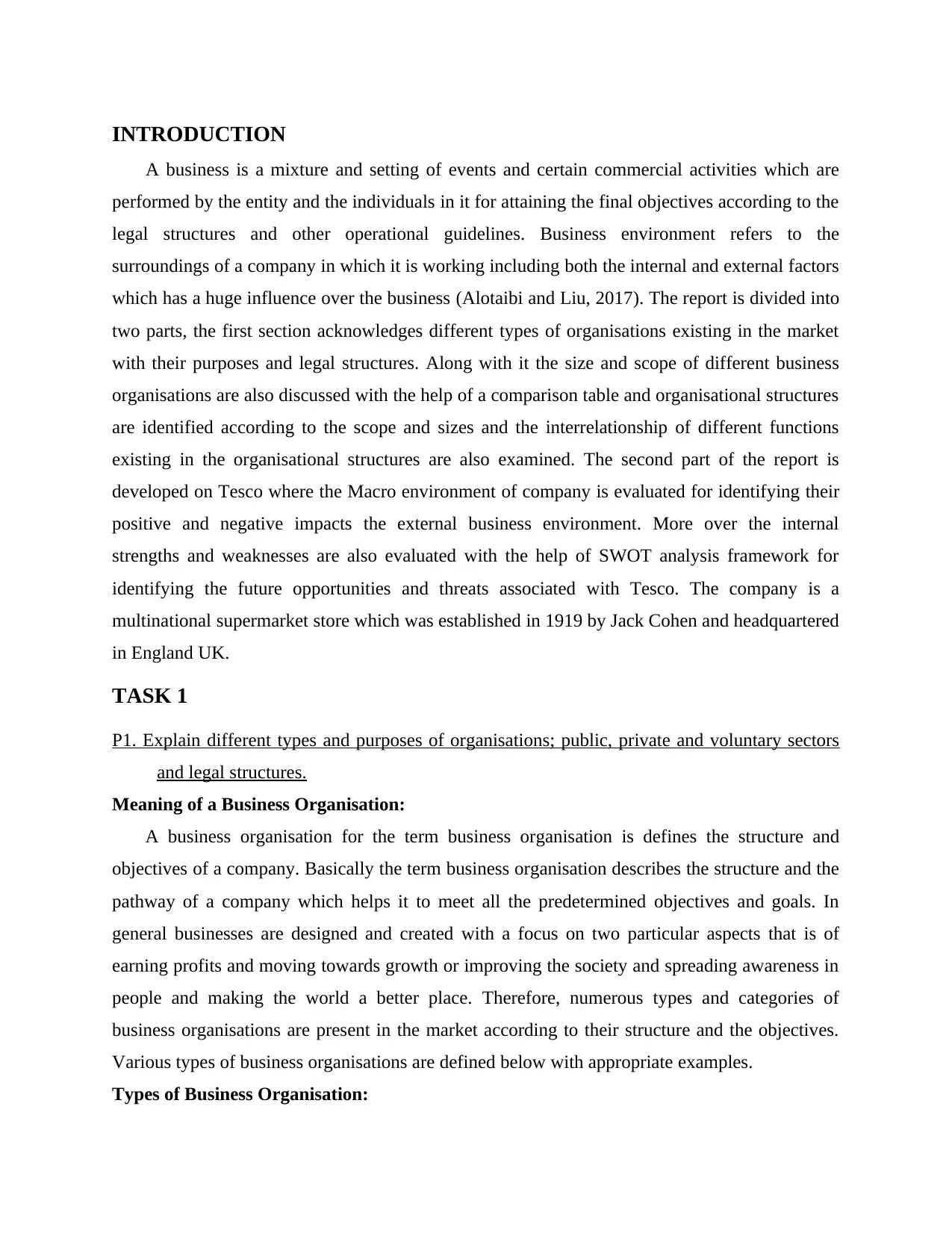
INTRODUCTION
A business is a mixture and setting of events and certain commercial activities which are
performed by the entity and the individuals in it for attaining the final objectives according to the
legal structures and other operational guidelines. Business environment refers to the
surroundings of a company in which it is working including both the internal and external factors
which has a huge influence over the business (Alotaibi and Liu, 2017). The report is divided into
two parts, the first section acknowledges different types of organisations existing in the market
with their purposes and legal structures. Along with it the size and scope of different business
organisations are also discussed with the help of a comparison table and organisational structures
are identified according to the scope and sizes and the interrelationship of different functions
existing in the organisational structures are also examined. The second part of the report is
developed on Tesco where the Macro environment of company is evaluated for identifying their
positive and negative impacts the external business environment. More over the internal
strengths and weaknesses are also evaluated with the help of SWOT analysis framework for
identifying the future opportunities and threats associated with Tesco. The company is a
multinational supermarket store which was established in 1919 by Jack Cohen and headquartered
in England UK.
TASK 1
P1. Explain different types and purposes of organisations; public, private and voluntary sectors
and legal structures.
Meaning of a Business Organisation:
A business organisation for the term business organisation is defines the structure and
objectives of a company. Basically the term business organisation describes the structure and the
pathway of a company which helps it to meet all the predetermined objectives and goals. In
general businesses are designed and created with a focus on two particular aspects that is of
earning profits and moving towards growth or improving the society and spreading awareness in
people and making the world a better place. Therefore, numerous types and categories of
business organisations are present in the market according to their structure and the objectives.
Various types of business organisations are defined below with appropriate examples.
Types of Business Organisation:
A business is a mixture and setting of events and certain commercial activities which are
performed by the entity and the individuals in it for attaining the final objectives according to the
legal structures and other operational guidelines. Business environment refers to the
surroundings of a company in which it is working including both the internal and external factors
which has a huge influence over the business (Alotaibi and Liu, 2017). The report is divided into
two parts, the first section acknowledges different types of organisations existing in the market
with their purposes and legal structures. Along with it the size and scope of different business
organisations are also discussed with the help of a comparison table and organisational structures
are identified according to the scope and sizes and the interrelationship of different functions
existing in the organisational structures are also examined. The second part of the report is
developed on Tesco where the Macro environment of company is evaluated for identifying their
positive and negative impacts the external business environment. More over the internal
strengths and weaknesses are also evaluated with the help of SWOT analysis framework for
identifying the future opportunities and threats associated with Tesco. The company is a
multinational supermarket store which was established in 1919 by Jack Cohen and headquartered
in England UK.
TASK 1
P1. Explain different types and purposes of organisations; public, private and voluntary sectors
and legal structures.
Meaning of a Business Organisation:
A business organisation for the term business organisation is defines the structure and
objectives of a company. Basically the term business organisation describes the structure and the
pathway of a company which helps it to meet all the predetermined objectives and goals. In
general businesses are designed and created with a focus on two particular aspects that is of
earning profits and moving towards growth or improving the society and spreading awareness in
people and making the world a better place. Therefore, numerous types and categories of
business organisations are present in the market according to their structure and the objectives.
Various types of business organisations are defined below with appropriate examples.
Types of Business Organisation:
⊘ This is a preview!⊘
Do you want full access?
Subscribe today to unlock all pages.

Trusted by 1+ million students worldwide
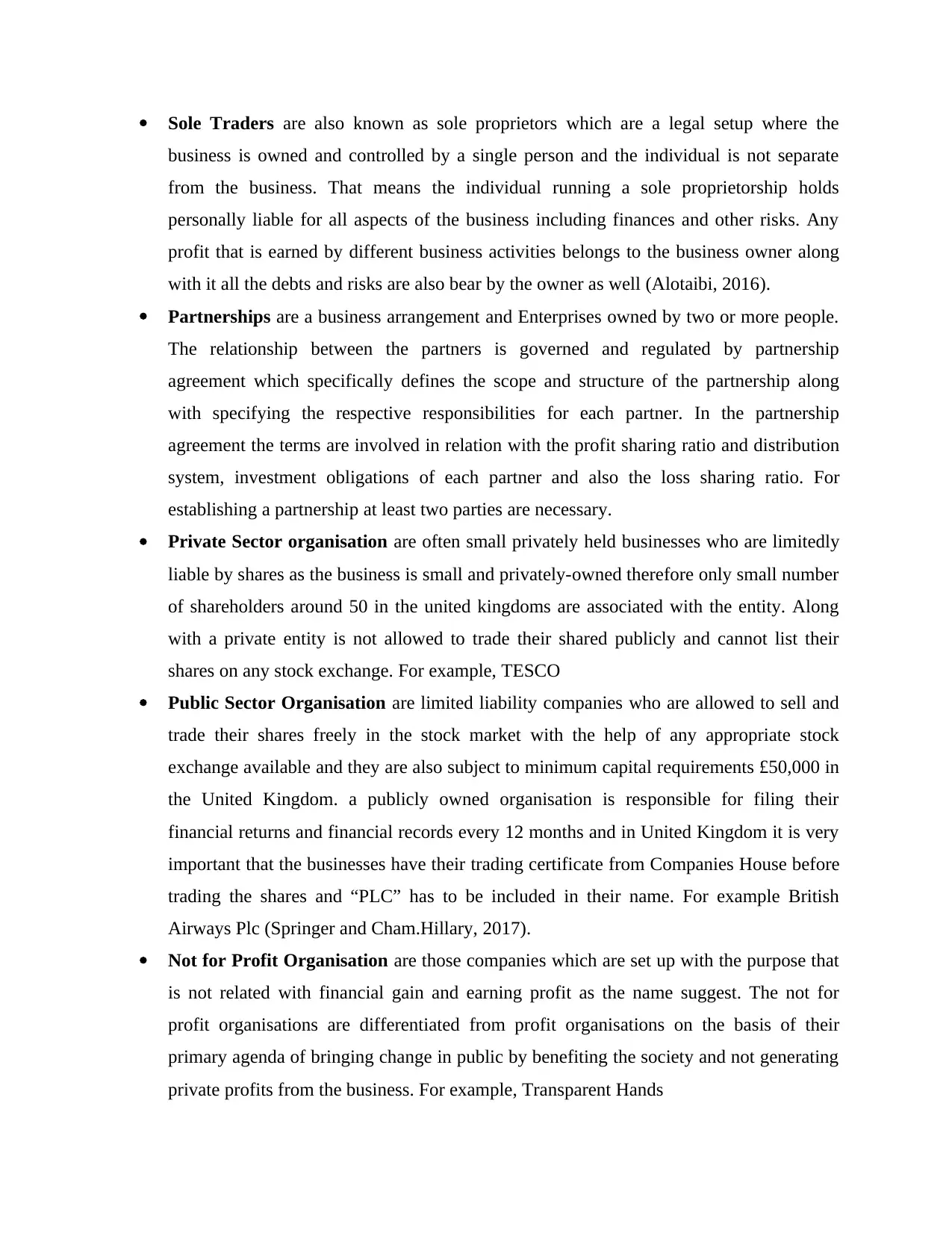
Sole Traders are also known as sole proprietors which are a legal setup where the
business is owned and controlled by a single person and the individual is not separate
from the business. That means the individual running a sole proprietorship holds
personally liable for all aspects of the business including finances and other risks. Any
profit that is earned by different business activities belongs to the business owner along
with it all the debts and risks are also bear by the owner as well (Alotaibi, 2016).
Partnerships are a business arrangement and Enterprises owned by two or more people.
The relationship between the partners is governed and regulated by partnership
agreement which specifically defines the scope and structure of the partnership along
with specifying the respective responsibilities for each partner. In the partnership
agreement the terms are involved in relation with the profit sharing ratio and distribution
system, investment obligations of each partner and also the loss sharing ratio. For
establishing a partnership at least two parties are necessary.
Private Sector organisation are often small privately held businesses who are limitedly
liable by shares as the business is small and privately-owned therefore only small number
of shareholders around 50 in the united kingdoms are associated with the entity. Along
with a private entity is not allowed to trade their shared publicly and cannot list their
shares on any stock exchange. For example, TESCO
Public Sector Organisation are limited liability companies who are allowed to sell and
trade their shares freely in the stock market with the help of any appropriate stock
exchange available and they are also subject to minimum capital requirements £50,000 in
the United Kingdom. a publicly owned organisation is responsible for filing their
financial returns and financial records every 12 months and in United Kingdom it is very
important that the businesses have their trading certificate from Companies House before
trading the shares and “PLC” has to be included in their name. For example British
Airways Plc (Springer and Cham.Hillary, 2017).
Not for Profit Organisation are those companies which are set up with the purpose that
is not related with financial gain and earning profit as the name suggest. The not for
profit organisations are differentiated from profit organisations on the basis of their
primary agenda of bringing change in public by benefiting the society and not generating
private profits from the business. For example, Transparent Hands
business is owned and controlled by a single person and the individual is not separate
from the business. That means the individual running a sole proprietorship holds
personally liable for all aspects of the business including finances and other risks. Any
profit that is earned by different business activities belongs to the business owner along
with it all the debts and risks are also bear by the owner as well (Alotaibi, 2016).
Partnerships are a business arrangement and Enterprises owned by two or more people.
The relationship between the partners is governed and regulated by partnership
agreement which specifically defines the scope and structure of the partnership along
with specifying the respective responsibilities for each partner. In the partnership
agreement the terms are involved in relation with the profit sharing ratio and distribution
system, investment obligations of each partner and also the loss sharing ratio. For
establishing a partnership at least two parties are necessary.
Private Sector organisation are often small privately held businesses who are limitedly
liable by shares as the business is small and privately-owned therefore only small number
of shareholders around 50 in the united kingdoms are associated with the entity. Along
with a private entity is not allowed to trade their shared publicly and cannot list their
shares on any stock exchange. For example, TESCO
Public Sector Organisation are limited liability companies who are allowed to sell and
trade their shares freely in the stock market with the help of any appropriate stock
exchange available and they are also subject to minimum capital requirements £50,000 in
the United Kingdom. a publicly owned organisation is responsible for filing their
financial returns and financial records every 12 months and in United Kingdom it is very
important that the businesses have their trading certificate from Companies House before
trading the shares and “PLC” has to be included in their name. For example British
Airways Plc (Springer and Cham.Hillary, 2017).
Not for Profit Organisation are those companies which are set up with the purpose that
is not related with financial gain and earning profit as the name suggest. The not for
profit organisations are differentiated from profit organisations on the basis of their
primary agenda of bringing change in public by benefiting the society and not generating
private profits from the business. For example, Transparent Hands
Paraphrase This Document
Need a fresh take? Get an instant paraphrase of this document with our AI Paraphraser
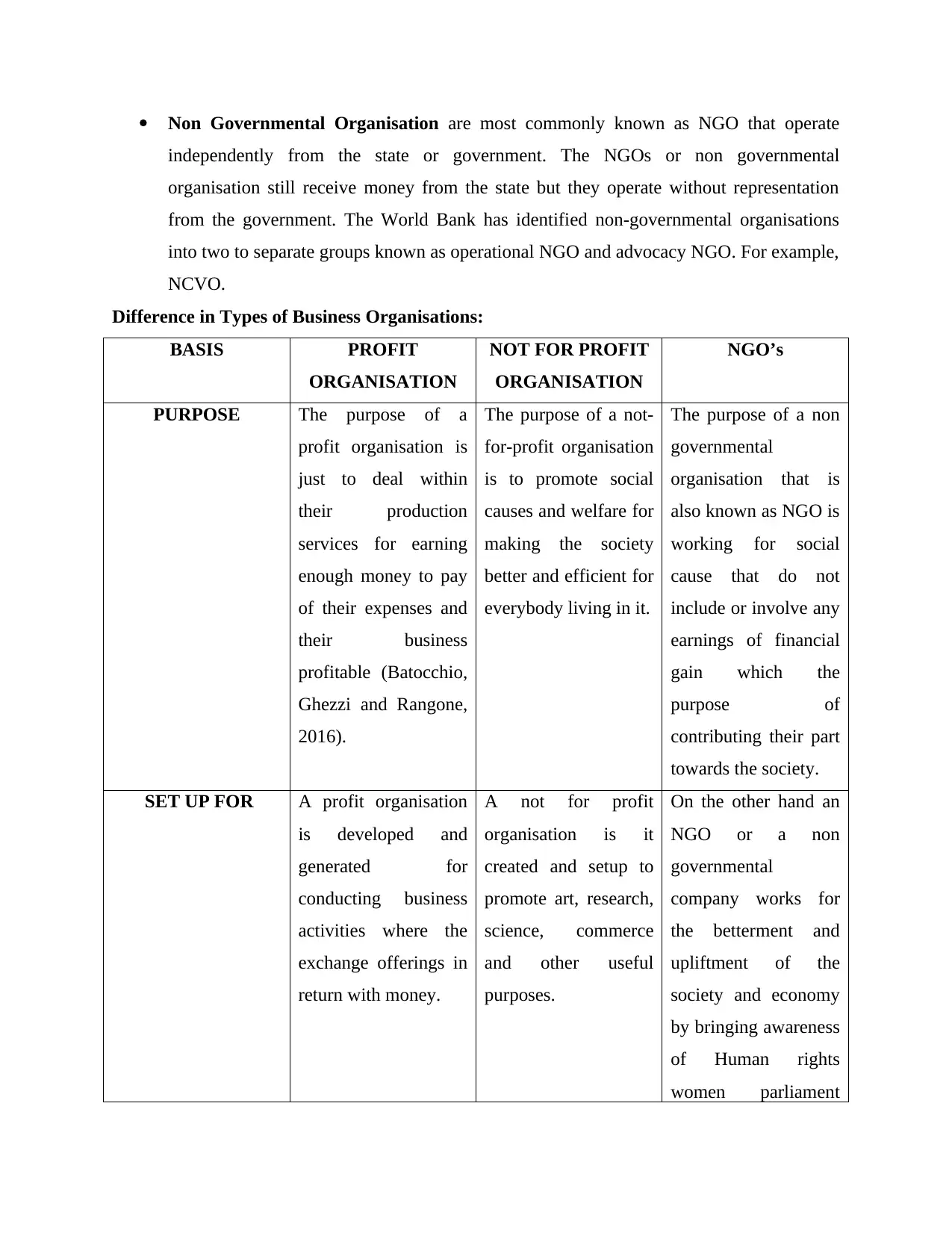
Non Governmental Organisation are most commonly known as NGO that operate
independently from the state or government. The NGOs or non governmental
organisation still receive money from the state but they operate without representation
from the government. The World Bank has identified non-governmental organisations
into two to separate groups known as operational NGO and advocacy NGO. For example,
NCVO.
Difference in Types of Business Organisations:
BASIS PROFIT
ORGANISATION
NOT FOR PROFIT
ORGANISATION
NGO’s
PURPOSE The purpose of a
profit organisation is
just to deal within
their production
services for earning
enough money to pay
of their expenses and
their business
profitable (Batocchio,
Ghezzi and Rangone,
2016).
The purpose of a not-
for-profit organisation
is to promote social
causes and welfare for
making the society
better and efficient for
everybody living in it.
The purpose of a non
governmental
organisation that is
also known as NGO is
working for social
cause that do not
include or involve any
earnings of financial
gain which the
purpose of
contributing their part
towards the society.
SET UP FOR A profit organisation
is developed and
generated for
conducting business
activities where the
exchange offerings in
return with money.
A not for profit
organisation is it
created and setup to
promote art, research,
science, commerce
and other useful
purposes.
On the other hand an
NGO or a non
governmental
company works for
the betterment and
upliftment of the
society and economy
by bringing awareness
of Human rights
women parliament
independently from the state or government. The NGOs or non governmental
organisation still receive money from the state but they operate without representation
from the government. The World Bank has identified non-governmental organisations
into two to separate groups known as operational NGO and advocacy NGO. For example,
NCVO.
Difference in Types of Business Organisations:
BASIS PROFIT
ORGANISATION
NOT FOR PROFIT
ORGANISATION
NGO’s
PURPOSE The purpose of a
profit organisation is
just to deal within
their production
services for earning
enough money to pay
of their expenses and
their business
profitable (Batocchio,
Ghezzi and Rangone,
2016).
The purpose of a not-
for-profit organisation
is to promote social
causes and welfare for
making the society
better and efficient for
everybody living in it.
The purpose of a non
governmental
organisation that is
also known as NGO is
working for social
cause that do not
include or involve any
earnings of financial
gain which the
purpose of
contributing their part
towards the society.
SET UP FOR A profit organisation
is developed and
generated for
conducting business
activities where the
exchange offerings in
return with money.
A not for profit
organisation is it
created and setup to
promote art, research,
science, commerce
and other useful
purposes.
On the other hand an
NGO or a non
governmental
company works for
the betterment and
upliftment of the
society and economy
by bringing awareness
of Human rights
women parliament
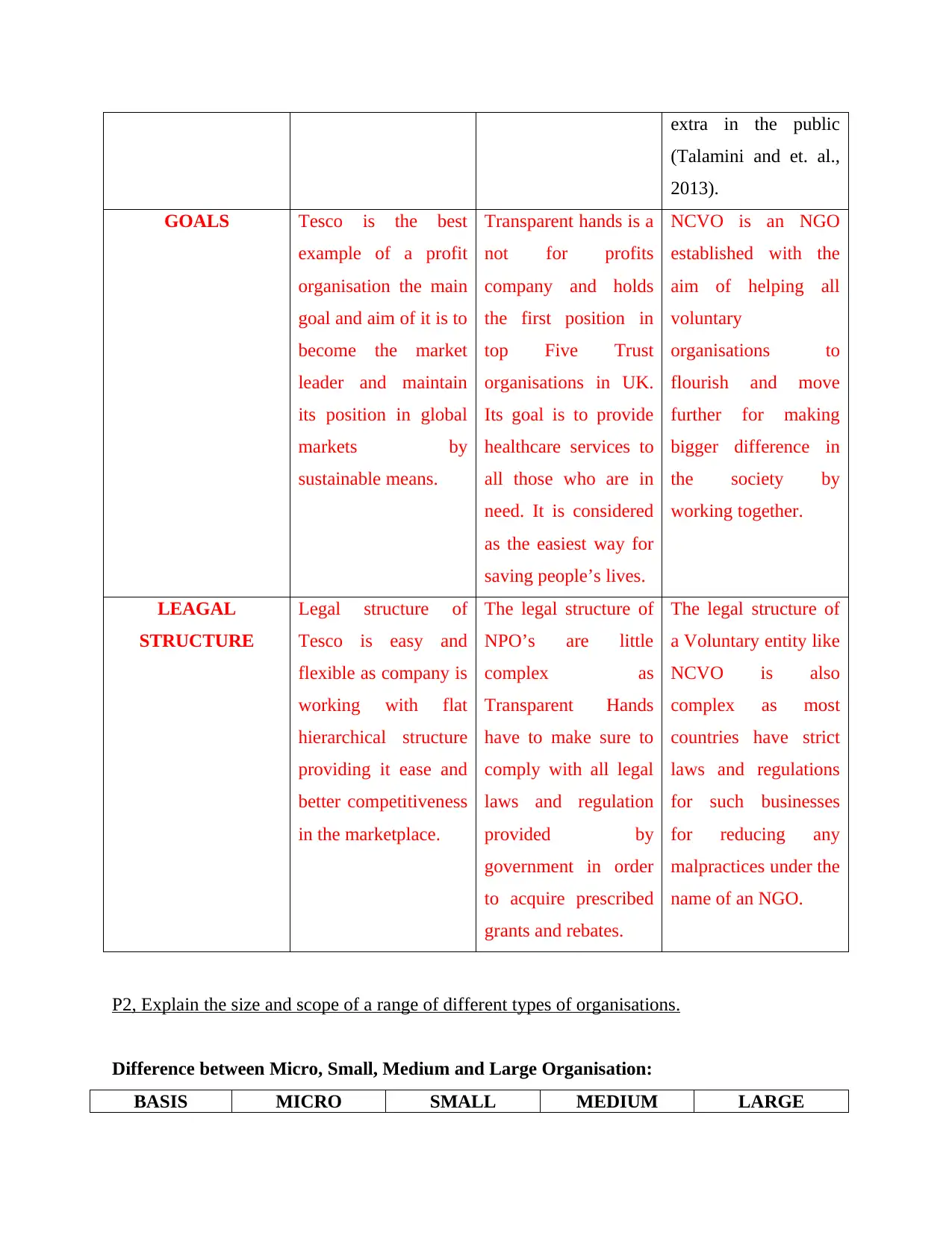
extra in the public
(Talamini and et. al.,
2013).
GOALS Tesco is the best
example of a profit
organisation the main
goal and aim of it is to
become the market
leader and maintain
its position in global
markets by
sustainable means.
Transparent hands is a
not for profits
company and holds
the first position in
top Five Trust
organisations in UK.
Its goal is to provide
healthcare services to
all those who are in
need. It is considered
as the easiest way for
saving people’s lives.
NCVO is an NGO
established with the
aim of helping all
voluntary
organisations to
flourish and move
further for making
bigger difference in
the society by
working together.
LEAGAL
STRUCTURE
Legal structure of
Tesco is easy and
flexible as company is
working with flat
hierarchical structure
providing it ease and
better competitiveness
in the marketplace.
The legal structure of
NPO’s are little
complex as
Transparent Hands
have to make sure to
comply with all legal
laws and regulation
provided by
government in order
to acquire prescribed
grants and rebates.
The legal structure of
a Voluntary entity like
NCVO is also
complex as most
countries have strict
laws and regulations
for such businesses
for reducing any
malpractices under the
name of an NGO.
P2, Explain the size and scope of a range of different types of organisations.
Difference between Micro, Small, Medium and Large Organisation:
BASIS MICRO SMALL MEDIUM LARGE
(Talamini and et. al.,
2013).
GOALS Tesco is the best
example of a profit
organisation the main
goal and aim of it is to
become the market
leader and maintain
its position in global
markets by
sustainable means.
Transparent hands is a
not for profits
company and holds
the first position in
top Five Trust
organisations in UK.
Its goal is to provide
healthcare services to
all those who are in
need. It is considered
as the easiest way for
saving people’s lives.
NCVO is an NGO
established with the
aim of helping all
voluntary
organisations to
flourish and move
further for making
bigger difference in
the society by
working together.
LEAGAL
STRUCTURE
Legal structure of
Tesco is easy and
flexible as company is
working with flat
hierarchical structure
providing it ease and
better competitiveness
in the marketplace.
The legal structure of
NPO’s are little
complex as
Transparent Hands
have to make sure to
comply with all legal
laws and regulation
provided by
government in order
to acquire prescribed
grants and rebates.
The legal structure of
a Voluntary entity like
NCVO is also
complex as most
countries have strict
laws and regulations
for such businesses
for reducing any
malpractices under the
name of an NGO.
P2, Explain the size and scope of a range of different types of organisations.
Difference between Micro, Small, Medium and Large Organisation:
BASIS MICRO SMALL MEDIUM LARGE
⊘ This is a preview!⊘
Do you want full access?
Subscribe today to unlock all pages.

Trusted by 1+ million students worldwide
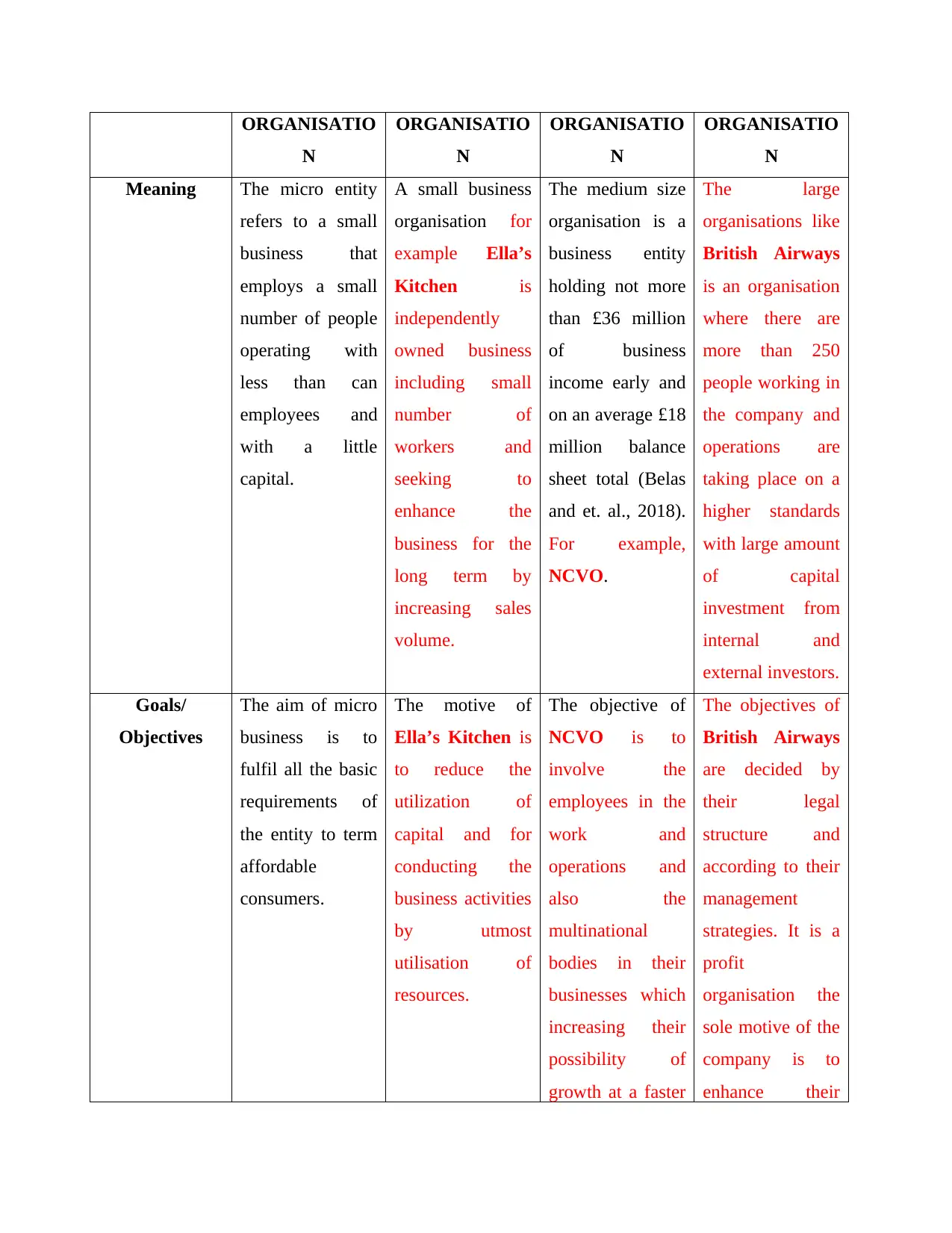
ORGANISATIO
N
ORGANISATIO
N
ORGANISATIO
N
ORGANISATIO
N
Meaning The micro entity
refers to a small
business that
employs a small
number of people
operating with
less than can
employees and
with a little
capital.
A small business
organisation for
example Ella’s
Kitchen is
independently
owned business
including small
number of
workers and
seeking to
enhance the
business for the
long term by
increasing sales
volume.
The medium size
organisation is a
business entity
holding not more
than £36 million
of business
income early and
on an average £18
million balance
sheet total (Belas
and et. al., 2018).
For example,
NCVO.
The large
organisations like
British Airways
is an organisation
where there are
more than 250
people working in
the company and
operations are
taking place on a
higher standards
with large amount
of capital
investment from
internal and
external investors.
Goals/
Objectives
The aim of micro
business is to
fulfil all the basic
requirements of
the entity to term
affordable
consumers.
The motive of
Ella’s Kitchen is
to reduce the
utilization of
capital and for
conducting the
business activities
by utmost
utilisation of
resources.
The objective of
NCVO is to
involve the
employees in the
work and
operations and
also the
multinational
bodies in their
businesses which
increasing their
possibility of
growth at a faster
The objectives of
British Airways
are decided by
their legal
structure and
according to their
management
strategies. It is a
profit
organisation the
sole motive of the
company is to
enhance their
N
ORGANISATIO
N
ORGANISATIO
N
ORGANISATIO
N
Meaning The micro entity
refers to a small
business that
employs a small
number of people
operating with
less than can
employees and
with a little
capital.
A small business
organisation for
example Ella’s
Kitchen is
independently
owned business
including small
number of
workers and
seeking to
enhance the
business for the
long term by
increasing sales
volume.
The medium size
organisation is a
business entity
holding not more
than £36 million
of business
income early and
on an average £18
million balance
sheet total (Belas
and et. al., 2018).
For example,
NCVO.
The large
organisations like
British Airways
is an organisation
where there are
more than 250
people working in
the company and
operations are
taking place on a
higher standards
with large amount
of capital
investment from
internal and
external investors.
Goals/
Objectives
The aim of micro
business is to
fulfil all the basic
requirements of
the entity to term
affordable
consumers.
The motive of
Ella’s Kitchen is
to reduce the
utilization of
capital and for
conducting the
business activities
by utmost
utilisation of
resources.
The objective of
NCVO is to
involve the
employees in the
work and
operations and
also the
multinational
bodies in their
businesses which
increasing their
possibility of
growth at a faster
The objectives of
British Airways
are decided by
their legal
structure and
according to their
management
strategies. It is a
profit
organisation the
sole motive of the
company is to
enhance their
Paraphrase This Document
Need a fresh take? Get an instant paraphrase of this document with our AI Paraphraser
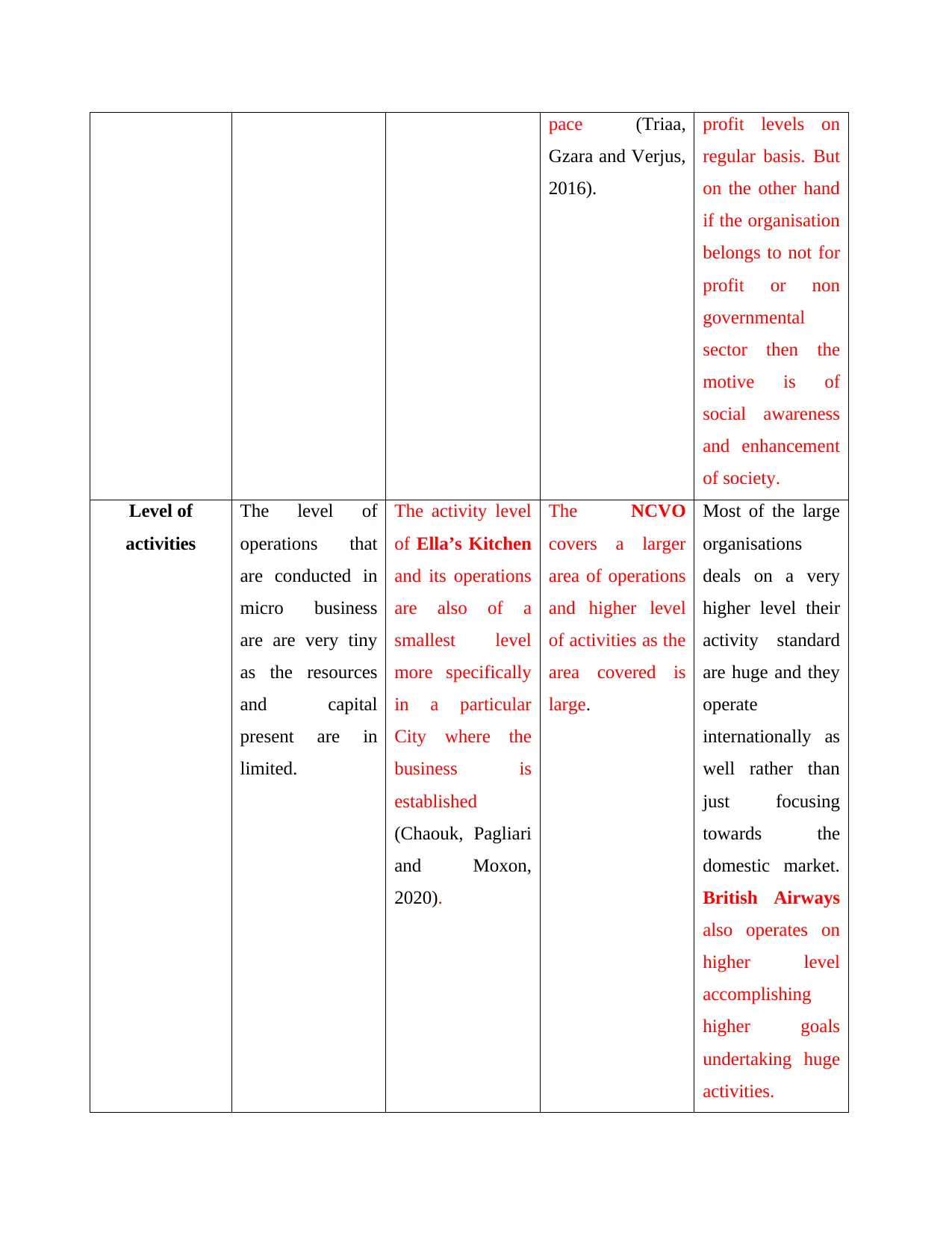
pace (Triaa,
Gzara and Verjus,
2016).
profit levels on
regular basis. But
on the other hand
if the organisation
belongs to not for
profit or non
governmental
sector then the
motive is of
social awareness
and enhancement
of society.
Level of
activities
The level of
operations that
are conducted in
micro business
are are very tiny
as the resources
and capital
present are in
limited.
The activity level
of Ella’s Kitchen
and its operations
are also of a
smallest level
more specifically
in a particular
City where the
business is
established
(Chaouk, Pagliari
and Moxon,
2020).
The NCVO
covers a larger
area of operations
and higher level
of activities as the
area covered is
large.
Most of the large
organisations
deals on a very
higher level their
activity standard
are huge and they
operate
internationally as
well rather than
just focusing
towards the
domestic market.
British Airways
also operates on
higher level
accomplishing
higher goals
undertaking huge
activities.
Gzara and Verjus,
2016).
profit levels on
regular basis. But
on the other hand
if the organisation
belongs to not for
profit or non
governmental
sector then the
motive is of
social awareness
and enhancement
of society.
Level of
activities
The level of
operations that
are conducted in
micro business
are are very tiny
as the resources
and capital
present are in
limited.
The activity level
of Ella’s Kitchen
and its operations
are also of a
smallest level
more specifically
in a particular
City where the
business is
established
(Chaouk, Pagliari
and Moxon,
2020).
The NCVO
covers a larger
area of operations
and higher level
of activities as the
area covered is
large.
Most of the large
organisations
deals on a very
higher level their
activity standard
are huge and they
operate
internationally as
well rather than
just focusing
towards the
domestic market.
British Airways
also operates on
higher level
accomplishing
higher goals
undertaking huge
activities.
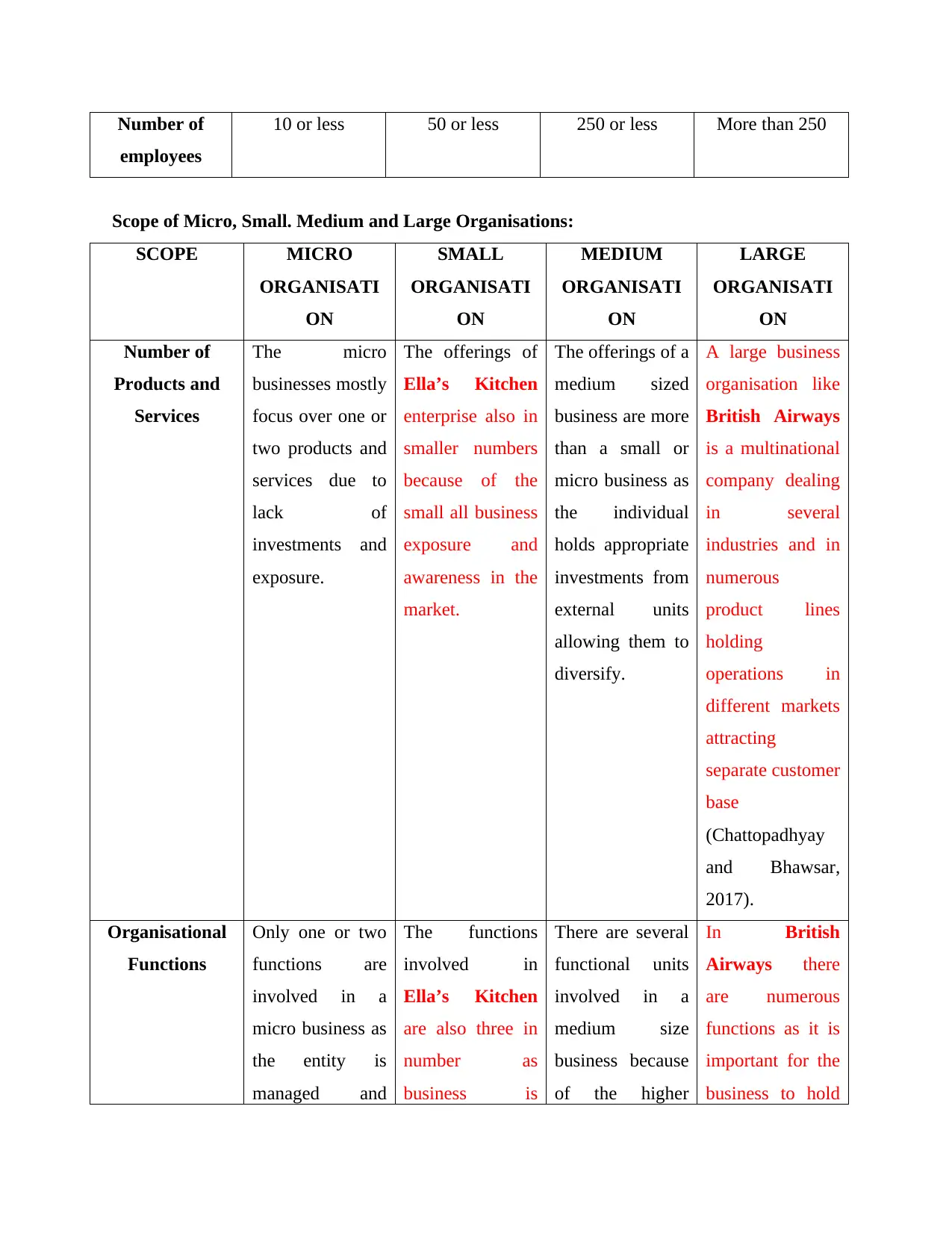
Number of
employees
10 or less 50 or less 250 or less More than 250
Scope of Micro, Small. Medium and Large Organisations:
SCOPE MICRO
ORGANISATI
ON
SMALL
ORGANISATI
ON
MEDIUM
ORGANISATI
ON
LARGE
ORGANISATI
ON
Number of
Products and
Services
The micro
businesses mostly
focus over one or
two products and
services due to
lack of
investments and
exposure.
The offerings of
Ella’s Kitchen
enterprise also in
smaller numbers
because of the
small all business
exposure and
awareness in the
market.
The offerings of a
medium sized
business are more
than a small or
micro business as
the individual
holds appropriate
investments from
external units
allowing them to
diversify.
A large business
organisation like
British Airways
is a multinational
company dealing
in several
industries and in
numerous
product lines
holding
operations in
different markets
attracting
separate customer
base
(Chattopadhyay
and Bhawsar,
2017).
Organisational
Functions
Only one or two
functions are
involved in a
micro business as
the entity is
managed and
The functions
involved in
Ella’s Kitchen
are also three in
number as
business is
There are several
functional units
involved in a
medium size
business because
of the higher
In British
Airways there
are numerous
functions as it is
important for the
business to hold
employees
10 or less 50 or less 250 or less More than 250
Scope of Micro, Small. Medium and Large Organisations:
SCOPE MICRO
ORGANISATI
ON
SMALL
ORGANISATI
ON
MEDIUM
ORGANISATI
ON
LARGE
ORGANISATI
ON
Number of
Products and
Services
The micro
businesses mostly
focus over one or
two products and
services due to
lack of
investments and
exposure.
The offerings of
Ella’s Kitchen
enterprise also in
smaller numbers
because of the
small all business
exposure and
awareness in the
market.
The offerings of a
medium sized
business are more
than a small or
micro business as
the individual
holds appropriate
investments from
external units
allowing them to
diversify.
A large business
organisation like
British Airways
is a multinational
company dealing
in several
industries and in
numerous
product lines
holding
operations in
different markets
attracting
separate customer
base
(Chattopadhyay
and Bhawsar,
2017).
Organisational
Functions
Only one or two
functions are
involved in a
micro business as
the entity is
managed and
The functions
involved in
Ella’s Kitchen
are also three in
number as
business is
There are several
functional units
involved in a
medium size
business because
of the higher
In British
Airways there
are numerous
functions as it is
important for the
business to hold
⊘ This is a preview!⊘
Do you want full access?
Subscribe today to unlock all pages.

Trusted by 1+ million students worldwide
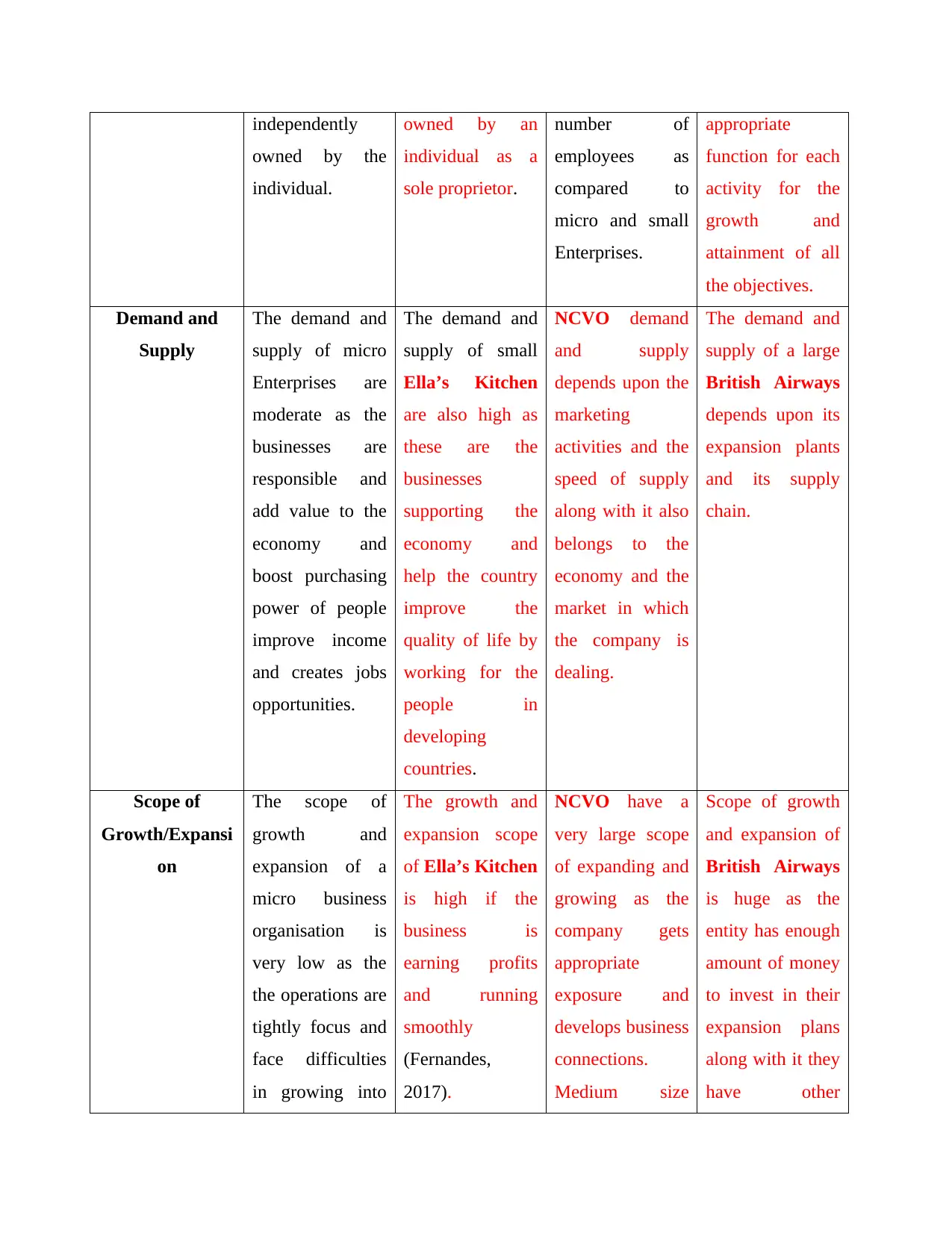
independently
owned by the
individual.
owned by an
individual as a
sole proprietor.
number of
employees as
compared to
micro and small
Enterprises.
appropriate
function for each
activity for the
growth and
attainment of all
the objectives.
Demand and
Supply
The demand and
supply of micro
Enterprises are
moderate as the
businesses are
responsible and
add value to the
economy and
boost purchasing
power of people
improve income
and creates jobs
opportunities.
The demand and
supply of small
Ella’s Kitchen
are also high as
these are the
businesses
supporting the
economy and
help the country
improve the
quality of life by
working for the
people in
developing
countries.
NCVO demand
and supply
depends upon the
marketing
activities and the
speed of supply
along with it also
belongs to the
economy and the
market in which
the company is
dealing.
The demand and
supply of a large
British Airways
depends upon its
expansion plants
and its supply
chain.
Scope of
Growth/Expansi
on
The scope of
growth and
expansion of a
micro business
organisation is
very low as the
the operations are
tightly focus and
face difficulties
in growing into
The growth and
expansion scope
of Ella’s Kitchen
is high if the
business is
earning profits
and running
smoothly
(Fernandes,
2017).
NCVO have a
very large scope
of expanding and
growing as the
company gets
appropriate
exposure and
develops business
connections.
Medium size
Scope of growth
and expansion of
British Airways
is huge as the
entity has enough
amount of money
to invest in their
expansion plans
along with it they
have other
owned by the
individual.
owned by an
individual as a
sole proprietor.
number of
employees as
compared to
micro and small
Enterprises.
appropriate
function for each
activity for the
growth and
attainment of all
the objectives.
Demand and
Supply
The demand and
supply of micro
Enterprises are
moderate as the
businesses are
responsible and
add value to the
economy and
boost purchasing
power of people
improve income
and creates jobs
opportunities.
The demand and
supply of small
Ella’s Kitchen
are also high as
these are the
businesses
supporting the
economy and
help the country
improve the
quality of life by
working for the
people in
developing
countries.
NCVO demand
and supply
depends upon the
marketing
activities and the
speed of supply
along with it also
belongs to the
economy and the
market in which
the company is
dealing.
The demand and
supply of a large
British Airways
depends upon its
expansion plants
and its supply
chain.
Scope of
Growth/Expansi
on
The scope of
growth and
expansion of a
micro business
organisation is
very low as the
the operations are
tightly focus and
face difficulties
in growing into
The growth and
expansion scope
of Ella’s Kitchen
is high if the
business is
earning profits
and running
smoothly
(Fernandes,
2017).
NCVO have a
very large scope
of expanding and
growing as the
company gets
appropriate
exposure and
develops business
connections.
Medium size
Scope of growth
and expansion of
British Airways
is huge as the
entity has enough
amount of money
to invest in their
expansion plans
along with it they
have other
Paraphrase This Document
Need a fresh take? Get an instant paraphrase of this document with our AI Paraphraser
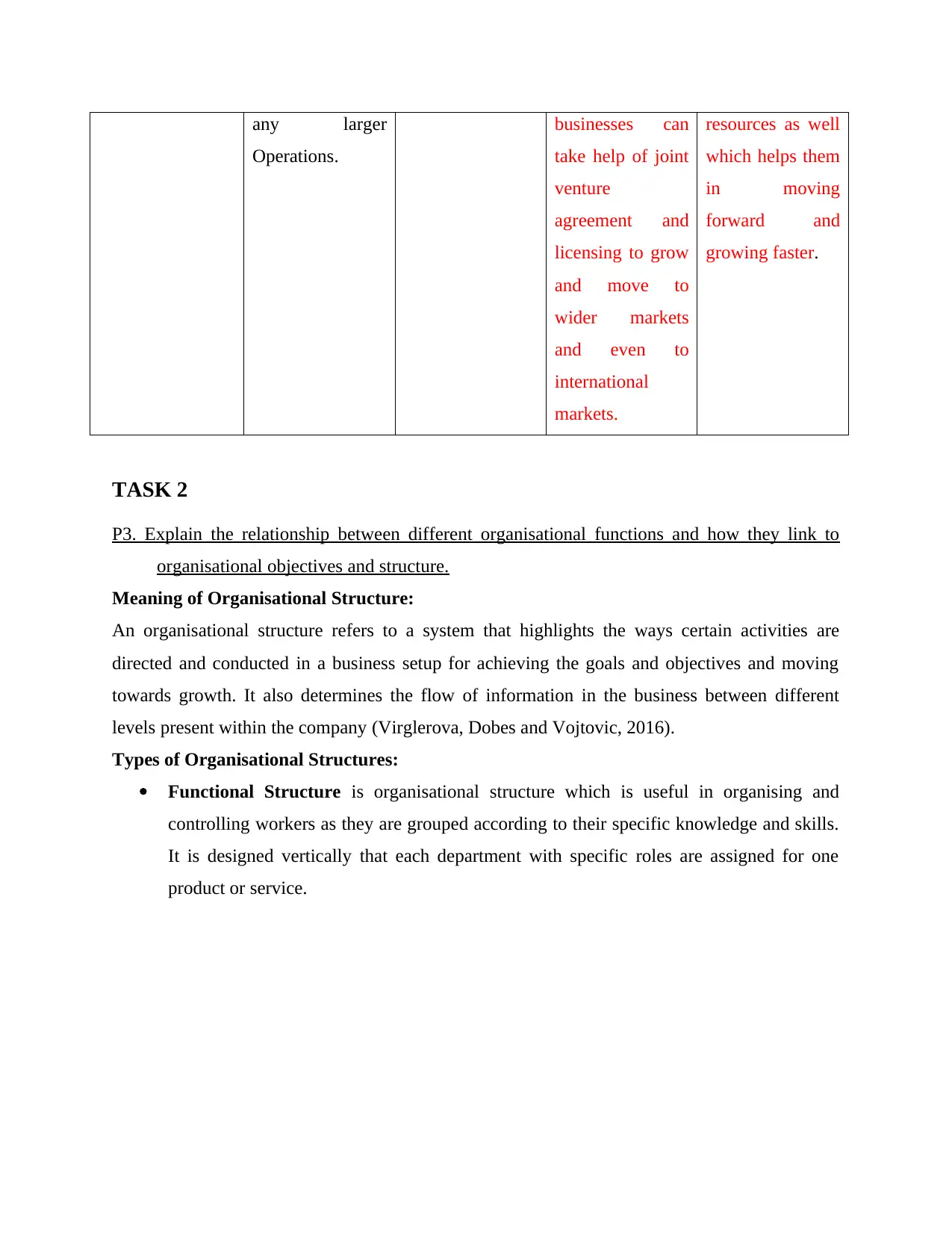
any larger
Operations.
businesses can
take help of joint
venture
agreement and
licensing to grow
and move to
wider markets
and even to
international
markets.
resources as well
which helps them
in moving
forward and
growing faster.
TASK 2
P3. Explain the relationship between different organisational functions and how they link to
organisational objectives and structure.
Meaning of Organisational Structure:
An organisational structure refers to a system that highlights the ways certain activities are
directed and conducted in a business setup for achieving the goals and objectives and moving
towards growth. It also determines the flow of information in the business between different
levels present within the company (Virglerova, Dobes and Vojtovic, 2016).
Types of Organisational Structures:
Functional Structure is organisational structure which is useful in organising and
controlling workers as they are grouped according to their specific knowledge and skills.
It is designed vertically that each department with specific roles are assigned for one
product or service.
Operations.
businesses can
take help of joint
venture
agreement and
licensing to grow
and move to
wider markets
and even to
international
markets.
resources as well
which helps them
in moving
forward and
growing faster.
TASK 2
P3. Explain the relationship between different organisational functions and how they link to
organisational objectives and structure.
Meaning of Organisational Structure:
An organisational structure refers to a system that highlights the ways certain activities are
directed and conducted in a business setup for achieving the goals and objectives and moving
towards growth. It also determines the flow of information in the business between different
levels present within the company (Virglerova, Dobes and Vojtovic, 2016).
Types of Organisational Structures:
Functional Structure is organisational structure which is useful in organising and
controlling workers as they are grouped according to their specific knowledge and skills.
It is designed vertically that each department with specific roles are assigned for one
product or service.
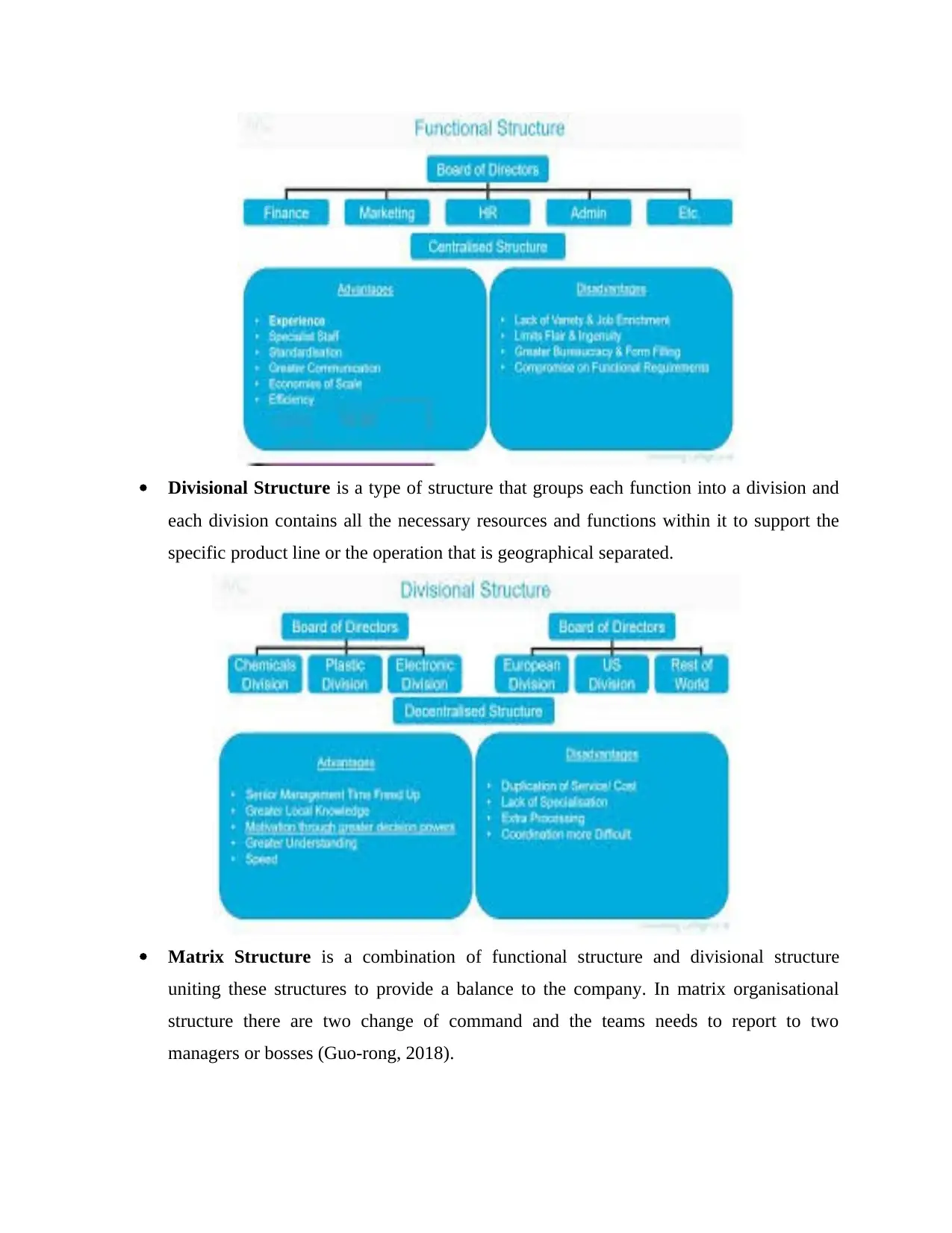
Divisional Structure is a type of structure that groups each function into a division and
each division contains all the necessary resources and functions within it to support the
specific product line or the operation that is geographical separated.
Matrix Structure is a combination of functional structure and divisional structure
uniting these structures to provide a balance to the company. In matrix organisational
structure there are two change of command and the teams needs to report to two
managers or bosses (Guo-rong, 2018).
each division contains all the necessary resources and functions within it to support the
specific product line or the operation that is geographical separated.
Matrix Structure is a combination of functional structure and divisional structure
uniting these structures to provide a balance to the company. In matrix organisational
structure there are two change of command and the teams needs to report to two
managers or bosses (Guo-rong, 2018).
⊘ This is a preview!⊘
Do you want full access?
Subscribe today to unlock all pages.

Trusted by 1+ million students worldwide
1 out of 23
Related Documents
Your All-in-One AI-Powered Toolkit for Academic Success.
+13062052269
info@desklib.com
Available 24*7 on WhatsApp / Email
![[object Object]](/_next/static/media/star-bottom.7253800d.svg)
Unlock your academic potential
Copyright © 2020–2025 A2Z Services. All Rights Reserved. Developed and managed by ZUCOL.
![Business and the Business Environment: Report for [University Name]](/_next/image/?url=https%3A%2F%2Fdesklib.com%2Fmedia%2Fimages%2Fbe%2F38fa8050ce8f491d8760aff1b89116bc.jpg&w=256&q=75)




